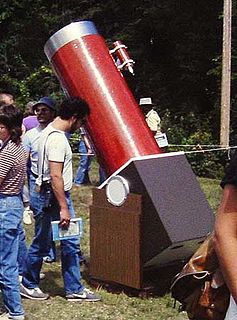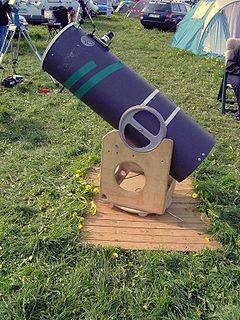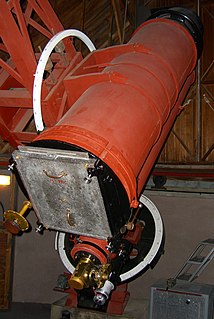
Astrophotography is photography of astronomical objects, celestial events, and areas of the night sky. The first photograph of an astronomical object was taken in 1840, but it was not until the late 19th century that advances in technology allowed for detailed stellar photography. Besides being able to record the details of extended objects such as the Moon, Sun, and planets, astrophotography has the ability to image objects invisible to the human eye such as dim stars, nebulae, and galaxies. This is done by long time exposure since both film and digital cameras can accumulate and sum light photons over these long periods of time.

A tripod is a portable three-legged frame or stand, used as a platform for supporting the weight and maintaining the stability of some other object. A tripod provides stability against downward forces and horizontal forces and movements about horizontal axes. The positioning of the three legs away from the vertical centre allows the tripod better leverage for resisting lateral forces.

A Dobsonian telescope is an altazimuth-mounted Newtonian telescope design popularized by John Dobson in 1965 and credited with vastly increasing the size of telescopes available to amateur astronomers. Dobson's telescopes featured a simplified mechanical design that was easy to manufacture from readily available components to create a large, portable, low-cost telescope. The design is optimized for observing faint, deep-sky objects such as nebulae and galaxies. This type of observation requires a large objective diameter of relatively short focal length and portability for travel to less light-polluted locations.

STS-85 was a Space Shuttle Discovery mission to perform multiple space science packages. It was launched from Kennedy Space Center, Florida, on 7 August 1997. A major experiment was the CRISTA-SPAS free-flyer which had various telescopes on board.

The Stratospheric Observatory for Infrared Astronomy (SOFIA) is an 80/20 joint project of NASA and the German Aerospace Center (DLR) to construct and maintain an airborne observatory. NASA awarded the contract for the development of the aircraft, operation of the observatory and management of the American part of the project to the Universities Space Research Association (USRA) in 1996. The DSI manages the German parts of the project which are primarily science and telescope related. SOFIA's telescope saw first light on May 26, 2010. SOFIA is the successor to the Kuiper Airborne Observatory. It will observe celestial magnetic fields, star-forming regions, comets, nebulae, and the galactic centre.

A Schmidt camera, also referred to as the Schmidt telescope, is a catadioptric astrophotographic telescope designed to provide wide fields of view with limited aberrations. The design was invented by Bernhard Schmidt in 1930.

An altazimuth or alt-azimuth mount is a simple two-axis mount for supporting and rotating an instrument about two perpendicular axes – one vertical and the other horizontal. Rotation about the vertical axis varies the azimuth of the pointing direction of the instrument. Rotation about the horizontal axis varies the altitude of the pointing direction.

An equatorial mount is a mount for instruments that compensates for Earth's rotation by having one rotational axis parallel to the Earth's axis of rotation. This type of mount is used for astronomical telescopes and cameras. The advantage of an equatorial mount lies in its ability to allow the instrument attached to it to stay fixed on any celestial object with diurnal motion by driving one axis at a constant speed. Such an arrangement is called a sidereal or clock drive.

ROSAT was a German Aerospace Center-led satellite X-ray telescope, with instruments built by West Germany, the United Kingdom and the United States. It was launched on 1 June 1990, on a Delta II rocket from Cape Canaveral, on what was initially designed as an 18-month mission, with provision for up to five years of operation. ROSAT actually operated for over eight years, finally shutting down on 12 February 1999.

The Maksutov is a catadioptric telescope design that combines a spherical mirror with a weakly negative meniscus lens in a design that takes advantage of all the surfaces being nearly "spherically symmetrical". The negative lens is usually full diameter and placed at the entrance pupil of the telescope. The design corrects the problems of off-axis aberrations such as coma found in reflecting telescopes while also correcting chromatic aberration. It was patented in 1941 by Russian optician Dmitri Dmitrievich Maksutov. Maksutov based his design on the idea behind the Schmidt camera of using the spherical errors of a negative lens to correct the opposite errors in a spherical primary mirror. The design is most commonly seen in a Cassegrain variation, with an integrated secondary, that can use all-spherical elements, thereby simplifying fabrication. Maksutov telescopes have been sold on the amateur market since the 1950s.

An astrograph is a telescope designed for the sole purpose of astrophotography. Astrographs are mostly used in wide field astronomical surveys of the sky and for detection of objects such as asteroids, meteors, and comets.

In photography, a tripod is used to stabilize and elevate a camera, a flash unit, or other photographic equipment. All photographic tripods have three legs and a mounting head to couple with a camera. The mounting head usually includes a thumbscrew that mates to a female threaded receptacle on the camera, as well as a mechanism to be able to rotate and tilt the camera when it is mounted on the tripod. Tripod legs are usually made to telescope, in order to save space when not in use. Tripods are usually made from aluminum, carbon fiber, steel, wood or plastic.

In automotive suspension, a control arm, also known as an A-arm, is a hinged suspension link between the chassis and the suspension upright or hub that carries the wheel.

The Corrective Optics Space Telescope Axial Replacement (COSTAR) is the instrument designed to correct Hubble Space Telescope's primary mirror spherical aberration for light focused at the FOC, FOS and GHRS instruments.
Polar alignment is the act of aligning the rotational axis of a telescope's equatorial mount or a sundial's gnomon with a celestial pole to parallel Earth's axis.

A Poncet Platform or Poncet mount is a type of equatorial platform that uses a simple polar pivot and an inclined plane. The motion of the mount allows any device sitting on that platform to track the apparent motion of the stars in the night sky. It is a highly suitable complement to Dobsonian telescope style altazimuth mounted telescopes in that it follows the design's philosophy of being easy to build using common materials without the need for specialized tools or machined parts.

An equatorial platform or equatorial table is an equatorial telescope mount in the form of a specially designed platform that allows any device sitting on it to track astronomical objects in the sky on an equatorial axis. They are used to give equatorial tracking to any device sitting on them, from small cameras up to entire observatory buildings. They are often used with altazimuth mounted telescopes, such as the common Dobsonian telescope type, to overcome that type of mount's inability to track the night sky. With careful polar alignment sub-arc second precision CCD imaging is entirely possible. Roeser Observatory, Luxembourg have contributed hundreds of astrometric measurements of Near Earth Asteroids to the Minor Planet Center using a home-built 20" Dobsonian telescope on an Osypowski equatorial platform.

A star trail is a type of photograph that uses long exposure times to capture the apparent motion of stars in the night sky due to Earth's rotation. A star-trail photograph shows individual stars as streaks across the image, with longer exposures yielding longer arcs.

NIRCam is an instrument aboard the to-be-launched James Webb Space Telescope. It has two major tasks, as an imager from 0.6 to 5 micron wavelength, and as a wavefront sensor to keep the 18-section mirrors functioning as one. In other words, it is a camera and is also used to provide information to align the 18 segments of the primary mirror. It is an infrared camera with ten mercury-cadmium-telluride (HgCdTe) detector arrays, and each array has an array of 2048x2048 pixels. The camera has a field of view of 2.2x2.2 arc minutes with an angular resolution of 0.07 arcsec at 2 microns. NIRCam is also equipped with coronagraphs, which helps to collect data on exoplanets near stars. It helps with imaging anything next to a much brighter object, because the coronagraph blocks that light. NIRCam is housed in the Integrated Science Instrument Module, to which it is attached physically by struts. It is designed to operate at 37 Kelvin, so it can detect infrared radiation at this wavelength. It is connected to the ISIM by struts and thermal straps connect to heat radiators, which helps maintain its temperature. The Focal Plane Electronics operated at 290 kelvin.






















